Many people get confused about exactly what gnats mean when they hear it used in context of homes or buildings. Well, gnats are pesky little flying insects with generally slender body with long and narrow wings. Most species measure not more than an inch long whereas some are only a fraction of an inch. These insects most often they fly in large numbers called clouds.
Gnats are broadly classified into two group: biting and non-biting. Biting gnats are most prevalent near water sources such as swamps, marshes, ponds and the edges of streams. Non-biting gnats are common in houses, garden and yards; and are generally considered a nuisance, though others are excellent pollinators. They tend to swarm around people, poultry, cows, dogs and cats.
Gnats are found in almost every ecosystem around the world except for the extreme north and south.
List of Gnats
- Fungus Gnats
- Fruit Flies
- Common Housefly
- Eye Gnats
- Buffalo Gnats
- Dung Flies
- Hessian Fly
- Highland Midges
- Drain Flies
- Sphaerocerid Fly
- Sand Flies
- Stable Flies
- Blow Flies
Description
Fungus Gnats

Fungus gnats also referred to as darkwinged fungus gnats are small, dark, short-lived flies, similar in appearance to mosquitoes that infest soil, potting mix, other container media and other sources of organic decomposition. They eat organic mulch, leaf mold, grass clippings, compost, root hairs and fungi.
Fungus gnats are typically harmless to humans, since they can’t bite and don’t spread diseases. They however, can pose danger to houseplants especially when their population multiplies in number and their larvae starts to feed on plants’ thin roots. Fungus gnats can also spread Pythium, a group of plant pathogens that causes ‘damping off’’ in seedlings.
Fruit Flies
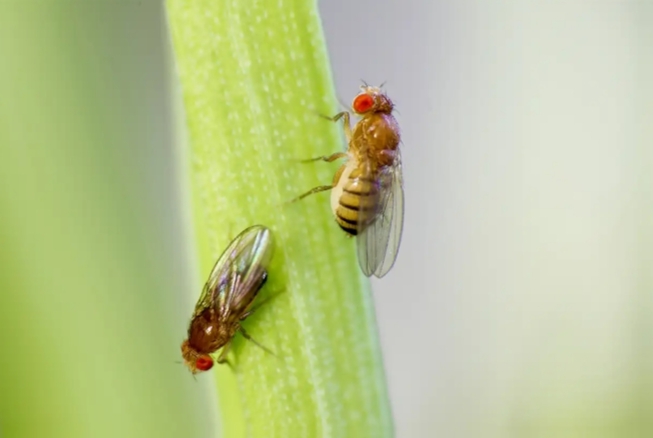
Fruit flies also referred to as vinegar flies are small fly insects with red eyes, tan thorax and black and grey abdomen with translucent wings. Fruit flies reproduce and mature quickly in the right conditions, the entire life cycle of a fruit fly can be completed in 5-6 days. They can appear at any time of the months or week and generally active during the day.
Fruit flies are majorly attracted to moist, fermenting fruits and vegetables as well as beer or liquor. However, they are also drawn to things such as drains, garbage disposals, empty bottles and cans, trash bags, cleaning rags and mops. Fruit flies do not bite but care should be taken to eliminate and prevent them in and around your house because they live and visit areas that are unsanitary.
Also Read: Different Types of White Spiders
Common Housefly
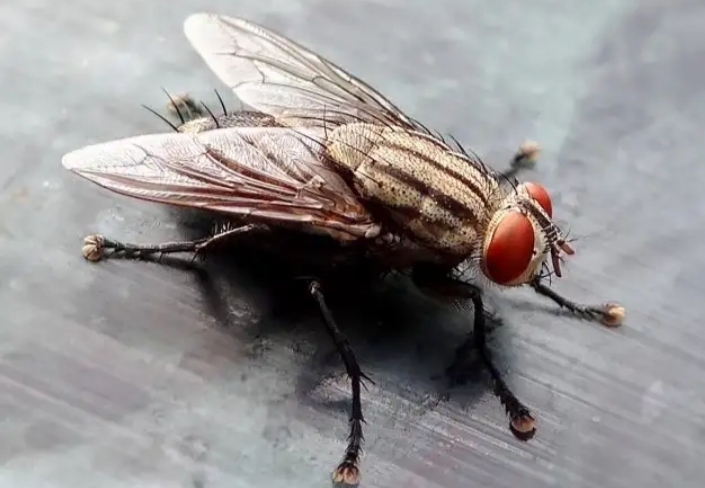
The common housefly is generally considered a household pest can easily be encountered in areas such as eating joints, fresh-markets, human refuse, manure, rotting organic matter etc. Houseflies are commonly associated with unsanitary environments. The adult housefly has two wings and four black stripes on its back. The abdomen typically appears checkered. Houseflies are often confused with flesh flies and stable flies. Housefly is probably the insect with the widest distribution in the world.
The housefly is notorious for its ability to spread diseases. This is largely attributed to its feeding habit and its structural morphology making it an effective vector in the transmission of diseases. Houseflies live for up to 3 weeks and are active during the warmer part of the year. Houseflies process visual information at least 5 times quicker than humans, enabling them to identify and avoid attempts to catch or swat them.
Eye Gnats
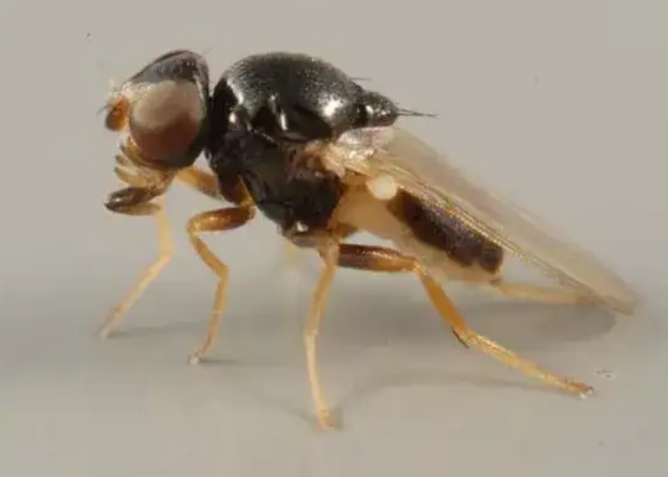
Eye gnats are small shiny black or orange flies with yellow to brown legs. They are very common in warm, dry regions. The majority of eye gnats develop in light, well drained, sandy soils that are freshly plowed or soils with decaying organic matter such as crops or manure with sufficient moisture. To produce their eggs, eye gnats feed on the protein found in body secretions such as mucus from the eyes and nose.
Eye gnats swarm around the head with an annoying persistence, darting at the eyes, mouth, nose or wounds of human or other animals. This is typically a nuisance insect because it doesn’t bite. Eye gnats have been linked with the spread of bovine mastitis in North America and in certain tropical regions, they are capable of vectoring diseases-causing bacteria such as yaws.
Buffalo Gnats
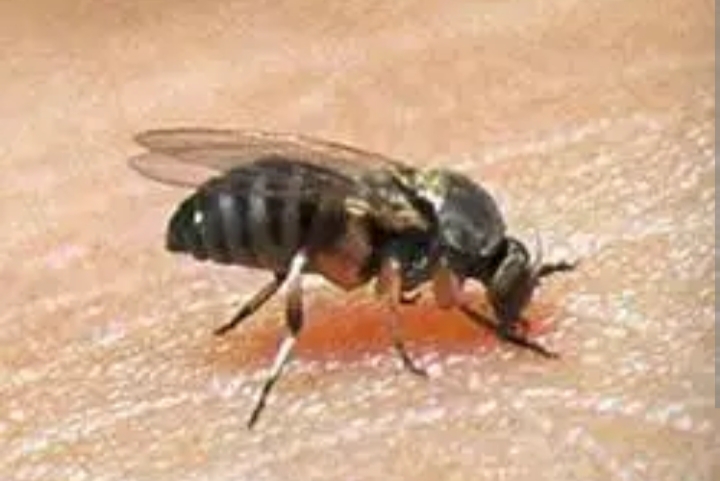
Buffalo gnats also referred as black flies are small black flies with a humpbacked appearance. These humps resemble a buffalo/bison’s hump, which is how they get their common name. contrary to their name, black flies may be gray, tan or even greenish in color. Both the males and females will feed on nectar and other sugar sources like plant sap and insect honeydew.
Adult black flies can fly over ten miles in search of food and usually breed in fast-moving water of streams and rivers. They are typically known to appear in late spring and early summer when they swarm and bite. They are known to bite humans, birds, chicken, domestic animals and wildlife. Male black flies do not bite, but females of most species must feed on blood to produce eggs.
Golden Dung Flies
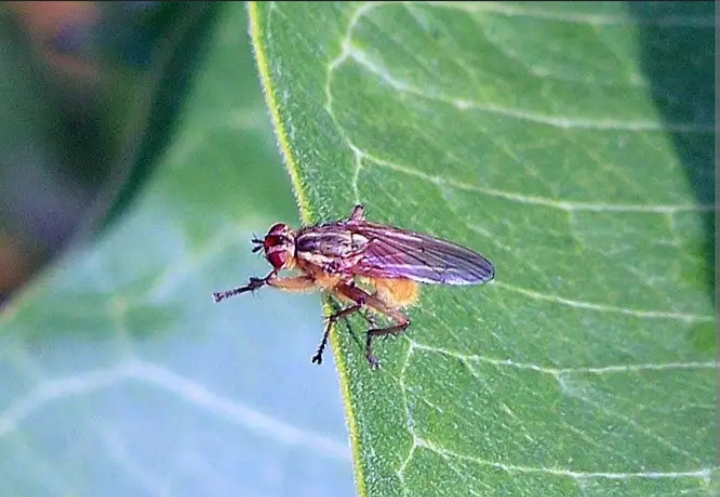
Commonly referred to as the yellow dung fly or golden dung fly is one of the most familiar and abundant flies in many parts of North America. The adult males are golden-yellow and are a little larger than females whereas females are little duller in color. Appearance can vary geographically, seasonally and because of a variety of other factors including larval food availability. As is with all flies, there is only one pair of wings, the hind wings reduced to small, knob-like structures that are used for balance in flight.
Golden dung fly is often associated with agricultural areas but it is commonly found on the feces of large mammals such as horses, cattle, sheep, deer and wild boar where it goes to breed. Golden dung fly predators include birds, bats and variety of insects including beetles that frequent the dung pats and patrolling robber flies.
Gall Gnats
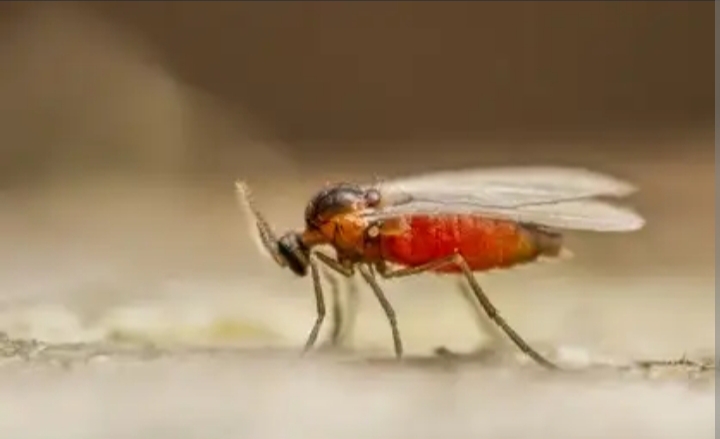
Gall gnats also referred to as gall midgets is a delicate insect resembling gnat flies in appearance and characterized by beaded, somewhat hairy antennae and proportionately long legs. The brightly colored larvae live in leaves and flowers, usually causing the formation of tissue swelling (galls) which distorts the foliage. After feeding, the larvae drop to the soil, pupate and emerge as reddish- or yellowish-brown flies within a week.
Gall midges affect trees, but are generally very host-specific. Some trees affected by gall midges include coyote brush, dogwood, fir, oak, pine and willow. Heavy infestations cause foliage to turn brown and to drop prematurely.
Hessian Fly
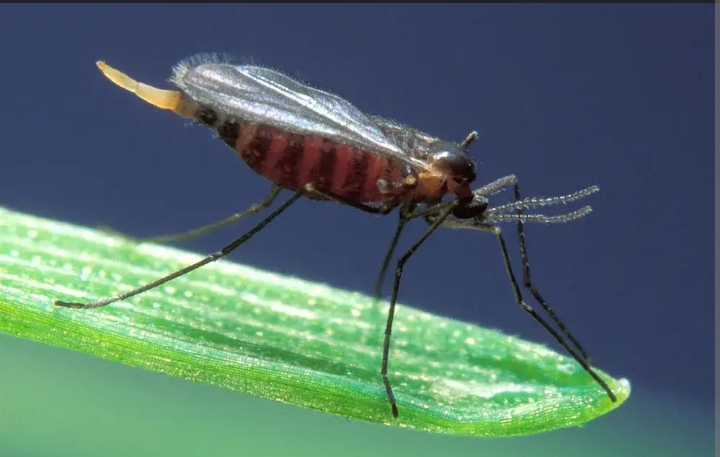
Hessian fly also referred to as barley midge is a type of gnat that is commonly seen on cereal crops including wheat, barley and rye. The adult Hessian fly is a tiny and mosquito-like in appearance with long legs and two wings. The adults too are weak fliers and are generally carried aloft by strong winds. The hessian fly usually has two generations annually, however if there is a high moisture during the growing season, there could be a total of three generations, in the spring, fall and in July or August.
After hatching from their eggs, legless Hessian fly maggots are initially a reddish color before turning a whitish. These maggots feed within grooves between the leaf sheath and stem and depending on weather, they reach their maximum size in two weeks. Hessian flies overwinter as full-grown larvae or maggots inside protective cases called flaxseed because of their resemblance to real flax seeds.
Highland Midges
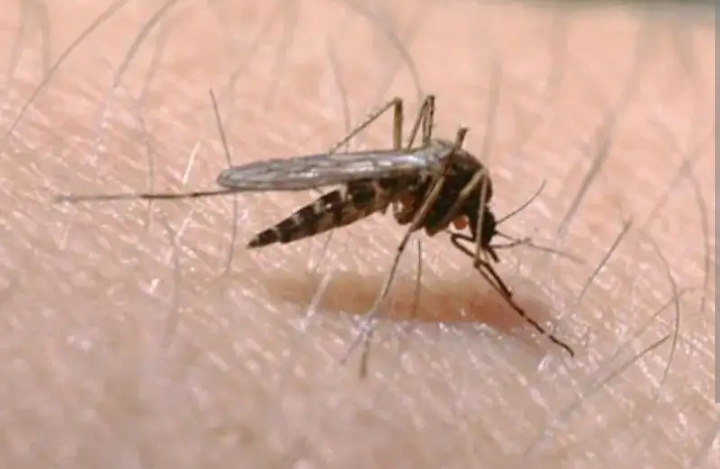
The Highland midge commonly referred to as midgie in Scotland, UK and Scandinavia. They are usually very prevalent from late spring to late summer. Female highland midges are well known for gathering in clouds and biting humans, though the majority of the blood they obtain comes from cattle, sheep and deer. They are most active just before dawn and sunset but bite at any time of the day.
Midges mate and lay eggs during the summer months each year. The eggs are laid in boggy ground or ground vegetation and hatch into larvae. Egg hatch takes less than 24 hours. During the summer mating season, males will find a female with whom to mate and will then die off.
Drain Gnats
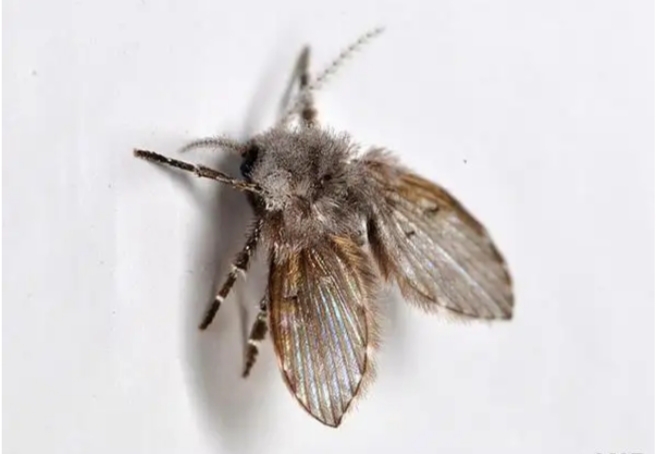
Drain gnats also referred to as drain flies or sink flies are light in appearance, usually beige/tan or light gray in color and can leave behind a powdery substance when they are crushed. They generally resemble fruit flies and are characterized by small, moth-like wings and round fuzzy bodies. Presence of drain flies in a place is a sign that water has been standing for a week or more within the place.
As their name suggest, drain flies inhabit drains, sewers, septic tanks and soil contaminated with sewage. They can also be found in the bathrooms with standing water. These gnats are harmless and won’t bite or sting, but since they arrive in large numbers, they can be quite a nuisance. Drain flies have a lifespan of between eight and 24 days but can lay and hatch up to 300 eggs in just under 56 hours.
Phorid Fly
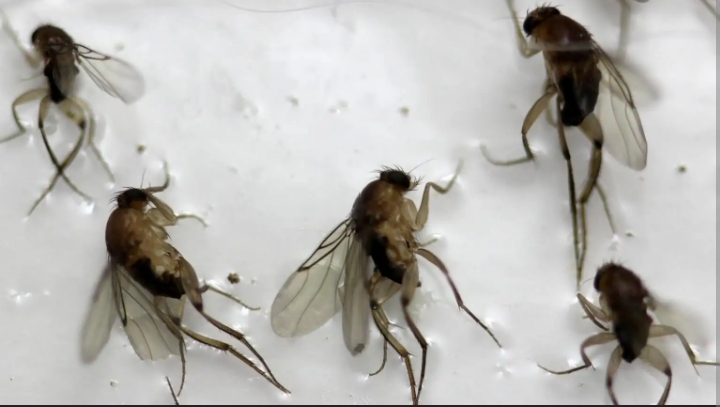
Phorid flies are small flies and when from the side, a pronounced hump to the thorax is seen. Their color ranges from black or brown to more rarely yellow, orange, pale grey and pale white. The head is usually rounded and, in some species, rounded towards the vertex. Phorid flies may easily be mistaken for fruit flies or drain flies. When disturbed, instead of flying away, many phorid flies will instead scuttle across surface to escape.
Phorid flies have several other names. Humpbacked flies describe their appearance when viewed from the side. Scuttle flies describes the jerky, erratic way they run instead of or before taking flight. Coffin flies describe one of the many situations in which they breed.
The entire phorid fly cycle varies from 14 days to 37 days but adult phorid flies only live one week. The length of the generation varies with temperature and food availability. Phorid eat a variety of decaying matter, especially organic material that gathers in drains or other plumbing. This includes decomposing food, fungi and insects.
Sand Flies
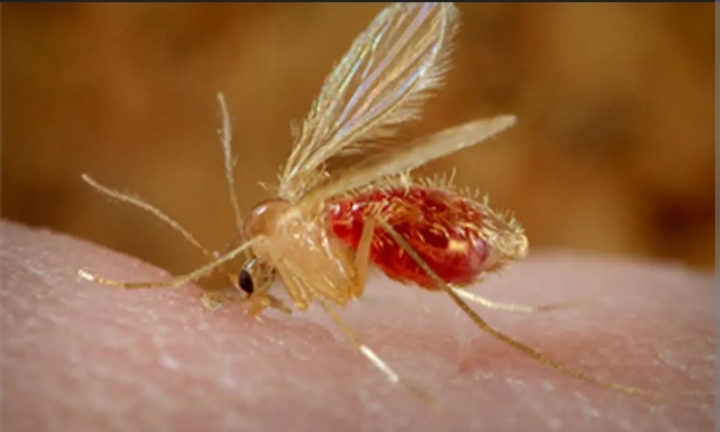
Sand flies are golden, brownish or gray in color. Sand flies naturally feed on blood from a wide range of mammal and are traditionally found in large numbers in the rural environment close to animals and humans. They have long, piercing mouthparts that are well adapted for sucking blood from their host. Most flies that bite humans feed during the evening and throughout the night. In some cases, flies will attack in the daytime, if they are disturbed while resting.
Sand flies hold their hairy-looking wings in a vertical V-shaped when at rest, a characteristic that distinguishes them from some other small flies. Also, the six legs on the adults are extremely long, being longer than the insect’s body. Sand flies are commonly found in cavities close the ground such as dry tree holes, hollow logs, palm tree crowns and the canopy of tropical and sub-tropical rain forest jungles. Occasionally, sand flies are active throughout the year or when there are summer peaks, but most frequently peak populations occur in spring.
Stable Flies

Stable flies are similar to house flies in size with a protruding piercing/sucking mouthpart and is a globally recognized pest of livestock. Both males and females feed on blood. They are as well attracted to various substances such as sugar, sweat and other plant and animal exudates. The life cycle of the stable fly is completed in 21 days with the fly’s life span ranging from 20-30 days. The larvae occur in various habitats including decaying vegetation, dry and wet soil, nests of insects and birds, fresh water and carrion.
Stable flies have a very painful bite. Affected animals will be regularly stomping their legs and bunching together. Stable flies are diurnal, feeding on their hosts during the early morning and late afternoon in warmer weather and in the middle of the day in cool weather. When feeding, stable flies can fully engorge in five minutes if left undisturbed.
Blow Flies
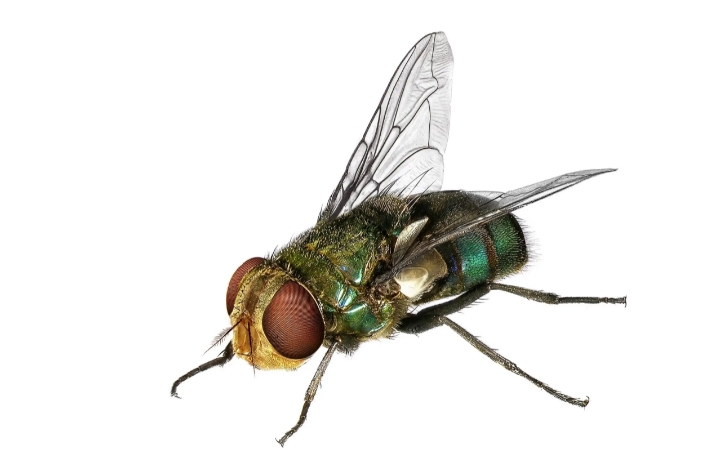
Blowfly also referred to as bottle fly are metallic in color and area usually green or blue in this metallic hue. Although they look similar to house flies, they are slightly bigger and have big heads with tough bodies. They have sponge-like mouthparts. The worm-like larvae, also known as maggots are pale yellow to white in color.
Blow flies are generally attracted to any animal carcass or other sources of meat. They are generally the first organisms to infect a dead body or piece of decaying meat. Adult blow flies can lay eggs in either manure or the carcasses of animals which then develop into fly maggots that feed on dead animals until they reach maturity and become fully active bow flies. These pests can also be found infesting areas where there are piles of garbage, piles of decaying vegetation and animal feces.